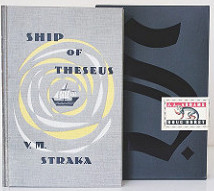You have no items in your cart. Want to get some nice things?
Go shopping I so desperately want to love this book – and, much like bumping into Catherine Zeta-Jones in a hotel lobby, I want it to love me back instantly, thus sealing our fate together for the rest of time.
I so desperately want to love this book – and, much like bumping into Catherine Zeta-Jones in a hotel lobby, I want it to love me back instantly, thus sealing our fate together for the rest of time.
I read in the region of two to three books a week. I don’t normally need them to love me back. Usually it’s best if they don’t but S has gone to so much effort to make an impact, I feel obliged. What can I tell you other than it’s a strange relationship we have. If the scaffolding that props up S as a novel has passed you by, perhaps an explanation is in order.
S consists of the novel Ship Of Theseus (written by fictional author, V.M. Straka) and the margin notes of two students conversing with each other (which becomes a whole different story) as they try to figure out the author’s true identity. Still with me? Good, because now it gets a little tough on the senses. Also included in the book are “supplementary materials” tucked in between the pages. (On which note – if you ever come to buy a copy, make sure you get one that’s still shrink wrapped. I have seen with my own eyes an eager reader open one up only for all of those materials to fall at their feet, hastily put them all back in the wrong place and thus, ruin the whole project.)
Carefully unwrapping my copy, I fell in love with the idea of the book without reading a word. Maybe it would be more honest to say I fell in love with the idea of the book in the same way I fell for Miss Zeta-Jones (I still can’t accept the Mrs Douglas tag) during Zorro. Lock, stock and two smoking barrels with no need to think about it any further than that.
Ship Of Theseus as a story itself is intriguing – if you can focus on it. A man with no past finds himself on a ship with a strange crew: so far, so Lost, so Treasure Island. That’s about all you need to know – and perhaps all you will ever know about the novel itself. Distracted by the margin notes poking you every step of the way with notions of ‘are we there yet’ from the back seat, I don’t know a single person who has made it to the end without having to restart several times and most of those failing on subsequent journeys as well.
Far more intriguing are the margin notes between Jennifer and Eric – a college senior and a grad student respectively – who are alternately checking the book out of the library and leaving said notes to each other with every checkout. With both parties going through something of an existential crisis, they appear to find some solace in their margin notes and wait… are they falling in love along the way?
It’s a clever plot/production device – an email discussion disassembled and rebuilt for the analogue age using hand written scrawl and block capitals to tell each of them apart.
Literary value aside, the icing on the cake lies in the wonderful extras inside. From the postcards of Brazilian birds, ancient photographs, photocopied telegrams and maps drawn on napkins right down to the library catalogue sticker on the spine and date stamps showing when it was loaned out, this is how you plan a project of value in the age of the internet.
I’m almost jealous. But is S a good book: one worth reading?
Not particularly. It’s hard to tell if it would stand up for itself without all of the associated paraphernalia. It’s like trying to watch Lost in the middle of a New Year’s Eve party. However, if you consider it to have been designed mostly to be an adventure in reading and how we think about books – as much of the media started to describe it on its initial release – it fares much better.
Then again, it is what it is: if you look upon it as a package and enter into the spirit in which it was created and don’t think too much about how it’s all supposed to fit together – or indeed – end, it’s simply brilliant.
Which is more or less the entire story of JJ Abrams’ career.
Conclusion? S is beautiful whichever way you look at it but, in the flesh, far too much hard work to live up to expectation. I proudly stand next to my Catherine Zeta-Jones analogy.

About Sion Smith
Sion Smith is a writer known for his work in dirty realism and pop-culture. He has a 'thing' for books, old monster movies and the rain. Also partial to samurai ways, art, airports, coffee and saving bears. He owns only twelve things because "you should never own so much that you can't leave town with your world in the car." You can find him at www.sionsmith.co.uk




